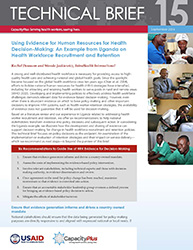September 2014
Rachel Deussom and Wanda Jaskiewicz, IntraHealth International
 A strong and well-distributed health workforce is necessary for providing access to high-quality health care and achieving national and global health goals. Since the spotlight became focused on the global health workforce crisis ten years ago (Chen et al. 2004), efforts to bolster national human resources for health (HRH) strategies have intensified, including for attracting and retaining health workers to serve posts in rural and remote areas (WHO 2010). Developing and implementing policies to effectively address health workforce challenges demands relevant data for evidence-based decision-making. However, even when there is abundant evidence on which to base policy-making and other important decisions to improve HRH systems, such as health worker retention strategies, the availability of evidence does not guarantee that it will be used for decision-making.
A strong and well-distributed health workforce is necessary for providing access to high-quality health care and achieving national and global health goals. Since the spotlight became focused on the global health workforce crisis ten years ago (Chen et al. 2004), efforts to bolster national human resources for health (HRH) strategies have intensified, including for attracting and retaining health workers to serve posts in rural and remote areas (WHO 2010). Developing and implementing policies to effectively address health workforce challenges demands relevant data for evidence-based decision-making. However, even when there is abundant evidence on which to base policy-making and other important decisions to improve HRH systems, such as health worker retention strategies, the availability of evidence does not guarantee that it will be used for decision-making.
Based on a literature review and our experience in Uganda related to addressing health worker recruitment and retention, we offer six recommendations to help national stakeholders transform evidence into policy decisions and subsequent action. In considering the Uganda example, we illustrate how the development and sharing of evidence can support decision-making for change in health workforce recruitment and retention policies. This technical brief focuses on policy decisions as the endpoint. An examination of the implementation or evaluation of retention strategies and their impact on service delivery—which we recommend as next steps—is beyond the purview of this brief.
|
Six Recommendations to Guide Use of HRH Evidence for Decision-Making
|
-
Ensure that evidence generation informs and drives a country-owned mandate.
-
Assess the costs of implementing the evidence-based policy intervention.
-
Involve relevant stakeholders, including technical experts and those with decision-making authority, in evidence dissemination and review.
-
Once agreement on the need for policy change has been reached, maximize momentum so that evidence is converted into action.
-
Ensure that an accountable stakeholder leadership group oversees a defined process for bringing an evidence-based policy decision to action.
-
Mitigate the effects of stakeholder turnover.
|
Next >>
A printer-friendly version is available.